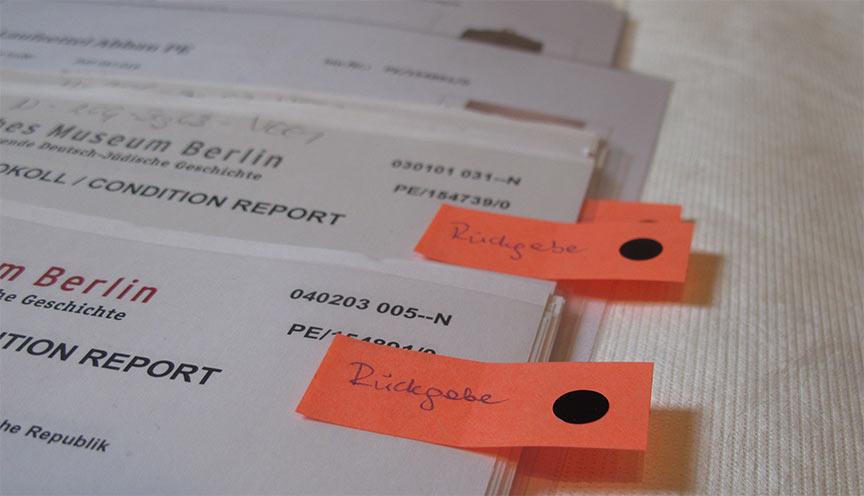
Collection Management
Responsibilities and Contact Persons
The objective of collection management is to protect and preserve the objects in our collections and items on loan to us to the greatest degree possible, as well as to document them and make them available to the public.
As conservators, we work to prevent damage to items in the collection by utilizing the proper packaging and storage in our art depots, and by monitoring the climate, light levels, and pests.
We also strive to exhibit objects without damaging them. We document their condition and identify their materials and techniques. If necessary, we stabilize the materials of individual objects by means of conservation treatments .
 X
X
Examining the condition of and framing Samson and Delilah by Max Liebermann, 1894, oil on canvas; Jewish Museum Berlin, accession GEM 86/22/0, photo: Stephan Lohrengel

Restoration of a volume of the first Talmud printed in Germany (Massechet Schabbat, Frankfurt/Oder, 1697). In order to reconnect the cover with the text block, the bands are extended; Jewish Museum Berlin, accession 2018/194/0 and VII.3. Masse 194, photo: Stephan Lohrengel.
As registrars, we coordinate loan conditions and organize on-time art transportation for international loans. In addition, we are the contact point regarding all of the administrative parameters for our exhibitions.
Collection documentation ensures that our collections are correctly registered and indexed, so that our objects and documents can be used for exhibitions and other projects. They should be accessible to researchers, and also available to all other interested parties. Our thesaurus of German-Jewish history allows you to do a targeted search by topic in our objects presented online.
 X
X
When an exhibition is being taken down, all of its objects are registered in lists and protocols in order to then safely pack and return them to their lenders; Jewish Museum Berlin, photo: Stephan Lohrengel.
Contact
Dr. Katharina Wippermann
Head of Collection Management
T +49 (0)30 259 93 577
k.wippermann@jmberlin.de
- Address
Jewish Museum Berlin
Lindenstraße 9–14
10969 Berlin
Dr. Iris Blochel-Dittrich
Collection Documentation
T +49 (0)30 259 93 442
i.blochel@jmberlin.de
Barbara Decker
Painting Conservator
T +49 (0)30 259 93 572
b.decker@jmberlin.de
Stephan Lohrengel
Paper Conservator
T +49 (0)30 259 93 551
s.lohrengel@jmberlin.de
Katrin Strube
Registrar Collections
T +49 (0)30 259 93 417
k.strube@jmberlin.de
Petra Hertwig
Registrar Temporary Exhibitions
T +49 (0)30 259 93 438
p.hertwig@jmberlin.de
I would like to depict or borrow an object from your collections. Who should I contact?
Your contacts for photo permissions are Valeska Wolfgram and Birgit Maurer-Porat (T +49 (0)30 259 93 433, email: fotodoku@jmberlin.de). Loan requests must be made at least six months in advance. For questions regarding administrative processes, please contact Katrin Strube (T +49 (0)30 259 93 417, email: k.strube@jmberlin.de).





